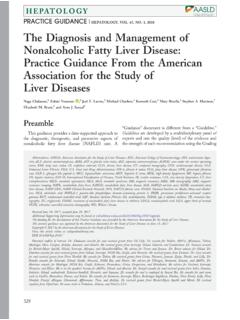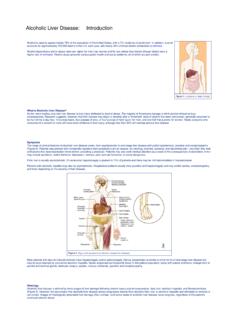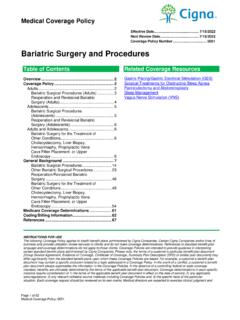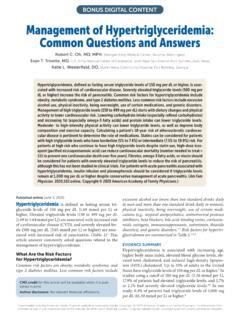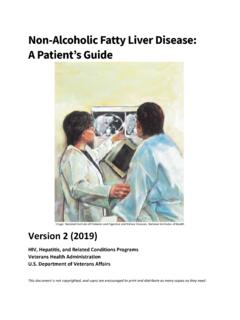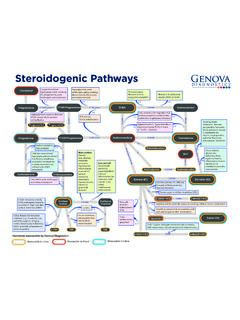Transcription of ELEVATED LIVER ENZYMES
1 ELEVATED LIVER ENZYMES . Eric F. Martin, MD. Transplant Hepatology Assistant Professor of Clinical Medicine Medical Director of Living Donor LIVER Transplant University of Miami ~ Miami Transplant Institute Financial Disclosures None Objectives 1. Identify the components of the LIVER biochemistry profile and understand their meaning if abnormal 2. Identify and understand the significance of the true LIVER function test LFTs . 3. Develop a differential diagnosis for abnormal LIVER biochemistries, including AST and/or ALT >1000. 4. Follow an organized approach to evaluate abnormal LIVER biochemistries Introduction Evaluation of abnormal LIVER ENZYMES in an otherwise healthy patient may pose challenge to most experienced clinician May not be necessary to pursue extensive evaluation for all abnormal tests, due to unnecessary expenses and procedural risks On the other hand, failure to investigate mild or moderate LIVER enzyme abnormalities could mean missing the early diagnosis of potentially life- threatening, but otherwise treatable conditions LIVER ENZYMES are readily available and included in many routine labs Estimated that 1%-9% of asymptomatic patients have ELEVATED LIVER enzyme levels when screened with standard LIVER function panels.
2 All persistent elevations of LIVER ENZYMES require methodical evaluation and appropriate working diagnosis Am J Gastroenterol 2017;12:18-35. Introduction The following tests are recommended by the American Association for the Study of LIVER Disease (AASLD) and the National Academy of Clinical Biochemistry (NCAB) to be used to evaluate patients with known or suspected LIVER disease - Aspartate aminotransferase (AST). Markers of hepatocellular injury - Alanine aminotransferase (ALT). - Alkaline phosphatase (ALP). - Total bilirubin Markers of cholestasis - Direct bilirubin - Total protein - Albumin True LIVER function tests ( LFTs ). - Prothrombin time (PT)/INR. Lab Orders Comprehensive Metabolic Panel (CMP). - Total protein, albumin, globulin, AST, ALT, alk phos, total bilirubin Hepatic Function Panel (7) - (LabCorp).
3 - Albumin, total bilirubin, direct bilirubin, AST, ALT, alk phos, total protein Hepatic Function Panel (Quest Diagnostics). - Total Protein, albumin, globulin (calculated), albumin/globulin ratio (calculated), total bilirubin, direct bilirubin, indirect bilirubin (calculated), alkaline phosphatase, AST, ALT. True LIVER Function Tests ( LFTs ). Lab Orders Albumin INR. Comprehensive Metabolic Panel (CMP). Bilirubin - Total protein, albumin, globulin, AST, ALT, alk phos, total bilirubin Hepatic Function Panel (7) - (LabCorp). - Albumin, total bilirubin, direct bilirubin, AST, ALT, alk phos, total protein Hepatic Function Panel (Quest Diagnostics). - Total Protein, albumin, globulin (calculated), albumin/globulin ratio (calculated), total bilirubin, direct bilirubin, indirect bilirubin (calculated), alkaline phosphatase, AST, ALT.
4 Investigation of abnormal LIVER biochemistries 1. Repeat testing to confirm isolated LIVER enzyme abnormality in otherwise healthy patient - Unless clinical context points toward obvious etiology ( abnormal AST/ALT coinciding with start of new medication). 2. History and physical exam 3. History and physical exam 4. History and physical exam 5. Detailed laboratory workup 6. Abdominal imaging 7. LIVER biopsy Investigation of abnormal LIVER biochemistries If abnormality persists, further evaluation should be based on 1) Pattern of LIVER injury 2) Magnitude of enzyme elevation Pattern of LIVER Injury LIVER Disease Category Isolated LIVER Biochemistry Hepatocellular Cholestatic Mixed hyperbilirubinemia AST/ALT ++ wnl/+ ++ wnl Alk phos wnl/+ ++ ++ wnl Bilirubin (total) wnl/+ to ++ wnl/+ to ++ wnl/+ to ++ +/++.
5 Pattern of LIVER Injury R ratio >5 Hepatocellular LIVER injury ALT value / ALT ULN. 2 5 Mixed pattern Alk Phos value / Alk Phos ULN. <2 Cholestatic LIVER injury Evaluation of LIVER enzyme elevations Complete History (1) Patient age and ethnicity (2) Presence of signs/symptoms of chronic LIVER disease - Pruritus, jaundice, ascites, encephalopathy, GI bleeding (3) Risk factors for viral hepatitis - IV/intranasal drug use, body piercings, tattoo, sexual history, transfusion hx (4) Presence of comorbid conditions - Type 2 DM, HTN, HLD, obesity (NALFD); autoimmune dz (autoimmune hepatitis); emphysema (A1AT); neuropsychiatric symptoms (Wilson dz). Evaluation of LIVER enzyme elevations Complete History (5) History of EtOH consumption, medication use, and toxin exposure (6) History of other autoimmune disorders - Autoimmune hepatitis, PBC.
6 (7) Family history of genetic conditions predisposing to LIVER disease - Hemochromatosis or Wilson disease (8) History of chronic diarrhea or inflammatory bowel disease (IBD). - IBD, celiac sprue, thyroid disorders, etc (9) Presence of signs/symptoms of heart failure - Congestive hepatopathy LIVER Biochemistries Hepatocellular Injury Cholestasis LIVER Function Tests AST Alkaline phosphatase Albumin ALT Bilirubin INR. LDH (lactate Gamma- Bilirubin dehydrogenase) glutamyltransferase (GGT). 5'-nucleotidase Serum Aminotransferases Collectively most sensitive marker of hepatocellular injury Aspartate aminotransferase AST (formerly SGOT). Alanine aminotransferase ALT (formerly SGPT). Important contributors to citric acid cycle AST ALT. Found in cytosol and mitochondria Found in cytosol Widely distributed throughout the Exists mainly LIVER , but exists in low body: LIVER > cardiac muscle > concentrations in kidney, heart, and skeletal muscle > kidney > brain > skeletal muscles pancreas > lung > leukocytes > More specific indicator of LIVER injury erythrocytes than AST.
7 Serum Aminotransferases Increases in serum aminotransferase levels reflect 1. Damage to tissues rich in these ENZYMES 2. Changes in cell membrane permeability to allow AST/ALT to leak into serum Degree of elevation does not correlate with extent of LIVER injury AST life < ALT life (ALT remains ELEVATED longer). PLEASE .PLEASE do not use the term transaminitis . Reference Range for ALT. The upper limits of normal (ULN) for ALT in healthy adults1,2. - Males: 29 33 U/L. - Females: 19 25 U/L. ULN for ALT recommended to guide management decisions3 (HBV. therapy). - Males: 35 U/mL. - Females: 25 U/mL. 1. Ann Intern Med 2002;137:1-10 2. Hepatology 2010;51:1577-1583 3. Hepatology 2018;67(4):1960-1999. ELEVATION OF SERUM AMINOTRANSFERASES. BORDERLINE MILD MODERATE SEVERE. <2x ULN 2-5x ULN 5-15x ULN >15x ULN.
8 Degree of elevation does not correlate with extent of LIVER injury Degree of elevation in AST and ALT can provide insight into etiology of LIVER injury Acute LIVER failure (ALF) is defined as rapid development of hepatocellular dysfunction (INR > ) and mental status changes (HE, any stage) in a patient without preexisting LIVER disease within 26 weeks of onset of illness regardless of ALT level ELEVATION OF SERUM AMINOTRANSFERASES. MODERATE SEVERE. BORDERLINE MILD. 5-15x ULN >15x ULN. <2x ULN 2-5x ULN. Non-alcoholic fatty LIVER Wilson disease Veno-occlusive disease disease (NAFLD) Alpha-1 antitrypsin deficiency (sinusoidal obstruction Alcoholic LIVER disease Toxic/ischemic hepatitis syndrome). Acute/chronic viral hepatitis Congestive hepatopathy Diffuse neoplastic Drug-induced LIVER injury (DILI) Total parenteral nutrition (TPN) infiltration of the LIVER Autoimmune hepatitis Budd-Chiari syndrome Hyperemesis gravidarum Hemochromatosis Hepatic artery HELLP.
9 Cirrhosis (of any etiology) injury/thrombosis Acute fatty LIVER of Celiac disease pregnancy Acute biliary obstruction Hemophagocytic LIVER trauma lymphohistiocytosis Post- LIVER surgery Nonhepatic Causes of ELEVATED Serum Aminotransferases Skeletal muscle damage (rhabdomyolysis). Strenuous exercise Cardiac muscle damage Thyroid disease Macro-AST. Heat stroke Hemolysis Adrenal insufficiency Anorexia nervosa ELEVATION OF SERUM AMINOTRANSFERASES. BORDERLINE MILD MODERATE SEVERE. <2x ULN 2-5x ULN 5-15x ULN >15x ULN. Acute viral hepatitis (especially HAV, HBV, HSV hepatitis). Ischemic hepatitis ( shock LIVER ). Vascular disorders (Budd-Chiari syndrome or acute hepatic artery occlusion Toxin or drug-induced LIVER injury (DILI) (Acetaminophen, cocaine, flakka). Autoimmune hepatitis Acute biliary obstruction Diffuse neoplastic infiltration of the LIVER Wilson disease MASSIVE.)
10 Rhabdomyolysis >10,000 UI/L. Heat stroke AST:ALT ratio ALT>AST. Typical for most LIVER conditions, including chronic viral hepatitis and NAFLD. AST:ALT >1. If AST >300 consider alternative diagnosis than alcoholic LIVER disease If AST <300. o AST:ALT >2 suggestive of alcoholic LIVER disease (AST A Scotch and Tonic). o AST:ALT >3 highly suggestive of ALD. Ratio results from deficiency of pyridoxal 5'-phosphate in pts with ALD. o ALT synthesis in LIVER requires pyridoxal phosphate more than AST synthesis The Alcoholic LIVER Disease/ nonalcoholic fatty LIVER Disease Index (ANI). ANI is novel scoring system that accurately distinguishes alcoholic LIVER disease (ALD). from nonalcoholic fatty LIVER disease (NAFLD). Most accurate when MELD <20. The Alcoholic LIVER Disease/ nonalcoholic fatty LIVER Disease Index (ANI).

